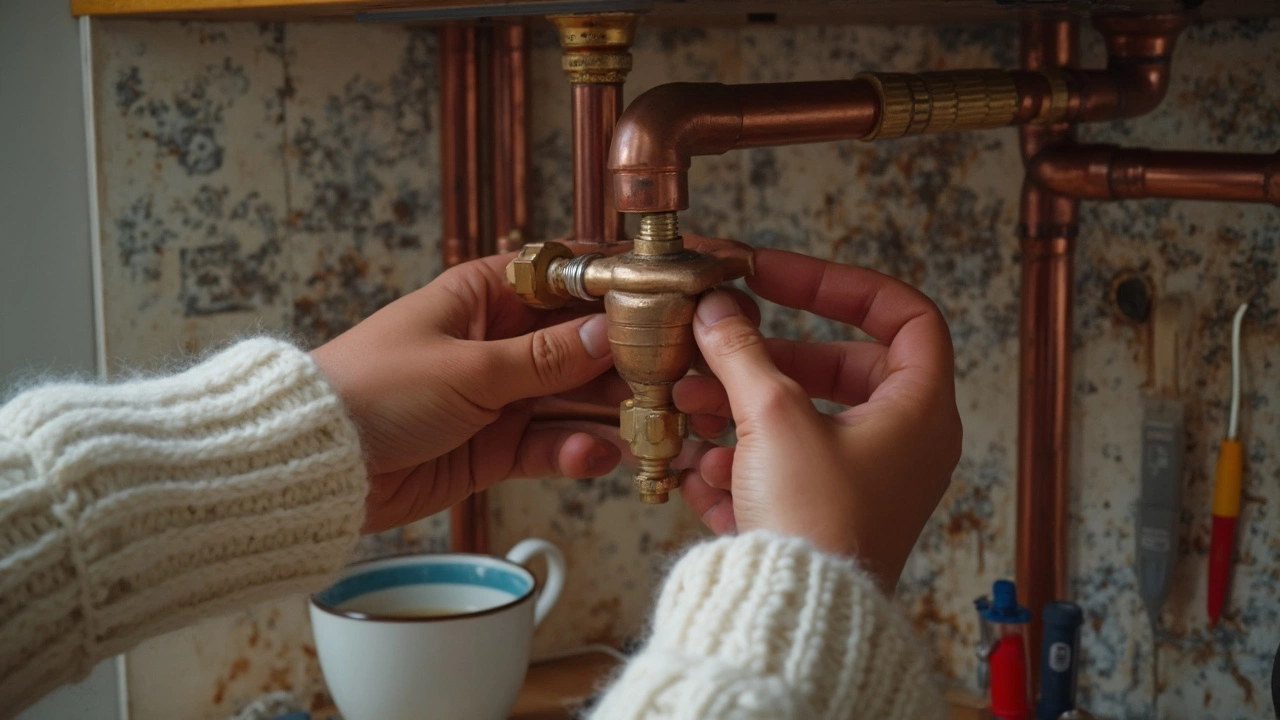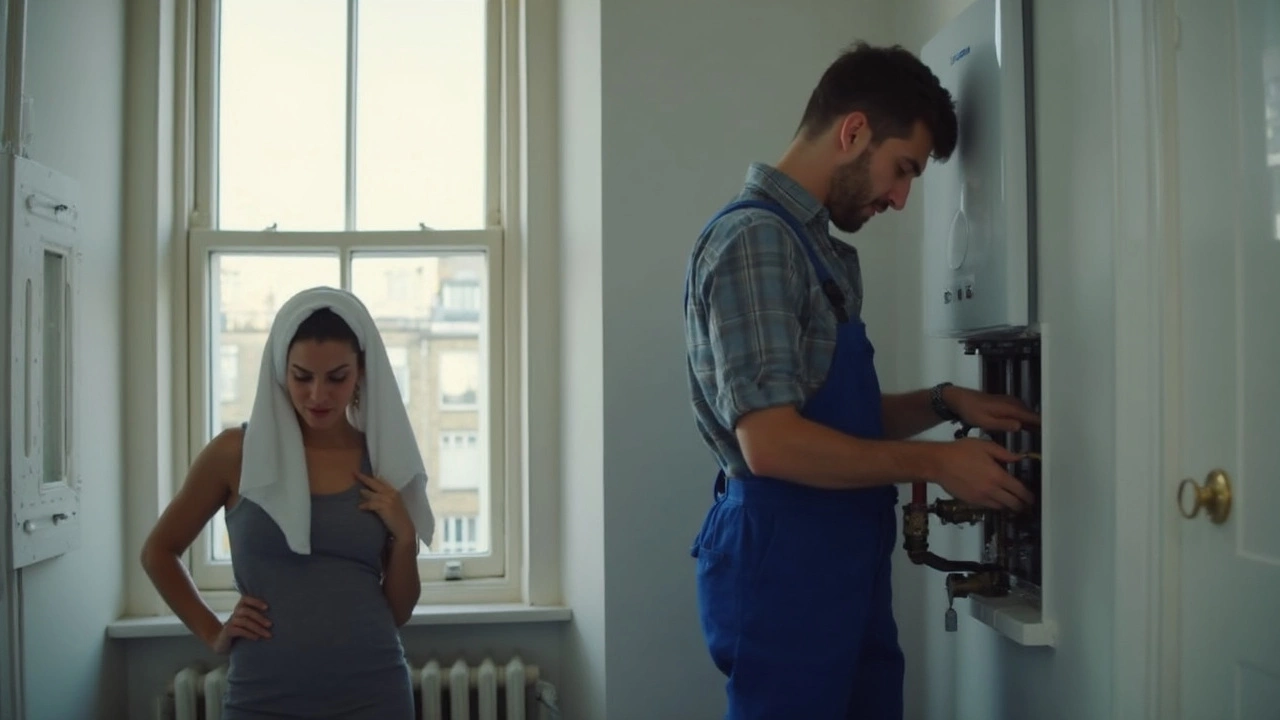One minute you’re enjoying your shower, the next it’s all ice-cold. That sudden switch from hot to cold isn’t just annoying—it’s also a clear sign something’s up with your water heater. Before you panic or call every plumber in your contacts, there are a few quick things you can check on your own.
Start with your water heater. Is it even getting power? For electric models, tripped breakers or blown fuses are common. For gas heaters, make sure you have gas and the pilot light is still burning. Sometimes the answer is as simple as a switch or a button that’s been accidentally bumped.
If you hear weird noises from the tank or notice leaks, those can be clues too. Weird rumbling often means sediment buildup, which can mess with both heating and efficiency. A puddle under the unit usually needs fast attention—leaks can get worse quick.
Most issues actually have pretty straightforward causes, and plenty of people fix minor problems themselves after a quick check. Getting to know your water heater now can save you time, cash, and a lot of shivering later.
- First Things to Check When Hot Water Disappears
- Electric vs. Gas Water Heaters: What Fails and Why
- Simple Fixes You Can Try Right Now
- When to Call a Professional
- Pro Tips to Keep Your Hot Water Flowing
First Things to Check When Hot Water Disappears
When your hot water suddenly goes cold, start by narrowing the problem down using a few quick checks. Most issues come from power, fuel, or something simple that gets overlooked. Here’s what you should look at first before moving on to tougher fixes or calling for help.
- Check Other Faucets: Is there zero hot water everywhere in the house, or just at one tap? If it’s every tap, your water heater is the problem. If only one spot’s cold, it might just be a problem with the faucet or a broken mixing cartridge.
- Inspect the Water Heater’s Power: For electric heaters, find your breaker box. Is the water heater breaker tripped? Flip it off and back on to reset. For gas heaters, listen for that faint hiss and check the pilot light—is it out?
- Temperature Setting: Kids love pressing buttons, and sometimes the thermostat gets bumped. The sweet spot is usually between 120–140°F (49–60°C). If it’s set much lower, water comes out lukewarm or cold.
- Look for Leaks and Noises: Wet spots under the heater, or banging and popping means you might have a leak or too much sediment. Either can knock your hot water out fast.
- Relief Valve and Water Supply: Peek at your water heater’s pressure relief valve—sometimes it gets stuck open and drains all your hot water in a hurry. If you don’t hear any water running, double-check the shut-off valve going into the heater.
Here’s a quick table to help you spot the problem source:
| Check | What to Do | What It Tells You |
|---|---|---|
| Hot water gone in all taps | Check heater itself | Issue with water heater |
| Breaker tripped (electric) | Reset breaker | Could be power surge or element issue |
| Pilot light off (gas) | Relight if safe | Most common gas heater issue |
| Temperature too low | Adjust thermostat | Accidentally changed setting |
| Wet around unit | Check for leaks | Tank or connection problem |
Some surveys show up to 40% of no-hot-water calls could have been solved by checking these basics. A quick look might save you time, stress, and a chunk of change.
Electric vs. Gas Water Heaters: What Fails and Why
Whether you have an electric or gas water heater, certain issues pop up more often than others—knowing the difference can help you troubleshoot fast. Electric water heaters mainly rely on heating elements inside the tank and a thermostat that tells those elements when to kick in. When hot water disappears, it’s often because one of these heating elements burnt out or a reset button tripped. Sometimes the thermostat gets stuck or just stops working. Power surges can even wreck the electrical parts, leaving you with nothing but cold water.
Gas water heaters work differently. They use a gas burner at the bottom, with a pilot light or an igniter to spark the action. The burner heats water as it moves through the tank. Most hot water failures in gas models come down to a failed pilot light, a busted thermocouple (that’s a safety device that keeps the gas flowing only when the pilot is on), or a clogged burner. Less commonly, the gas valve itself goes bad, which stops the flow of fuel so the burner can’t do its job.
Here’s a quick breakdown of what can go wrong with each type:
- Electric water heaters: Burned-out heating elements, faulty thermostat, tripped circuit breaker, or loose wiring.
- Gas water heaters: Pilot light out, broken thermocouple, gas line problem, dirty burner, or failed gas valve.
If your water heater is sputtering or flat-out dead, check what kind you have first. Each type has its own weak points. Electric units can be checked by resetting the breaker or hitting the reset button on the unit itself; for gas models, look for a relit pilot or check if you smell gas (and if you do, get professional help right away).
Remember, hot water vanishing usually has a short list of usual suspects. If you troubleshoot with the fuel type in mind, you can often zero in on the fix fast, or at least figure out if it’s something the pros need to handle.

Simple Fixes You Can Try Right Now
If your hot water suddenly stops, don’t assume it’s a disaster—sometimes it just takes a quick action to get things back to normal. A lot of these checks you can do with zero plumbing experience.
- Reset the breaker or replace a fuse: For electric water heaters, just find your main panel and see if the breaker for your water heater has tripped. If it’s off, flip it back on. For fuses, look for one that’s blown and swap it.
- Check the thermostat: Both electric and gas models have a thermostat. If it’s set too low, turn it up a bit—120°F is a safe, common setting. Sometimes thermostats get accidentally bumped and need a reset.
- Relight the pilot light (Gas Heaters): If you’ve got a gas heater and no hot water, the pilot light might have gone out. Follow the instructions printed on the tank or in your manual. Most new tanks have an easy ignition button, but older ones may need matches.
- Look for the reset button: Electric heaters usually have a red or black reset button, often behind a small access panel. Push the button and wait to see if the heater kicks back on. If it trips again right away, there’s probably a deeper problem.
- Check water supply valves: Make sure the cold water supply valve is fully open. If someone closed it by mistake, hot water stops flowing in just a few minutes.
- Flush the tank: If your water heats up slowly or not at all, sediment might be blocking things. Attach a hose to the tank’s drain valve and flush out a few gallons (always turn off power or gas before starting).
Try these steps before you grab the phone. These are known go-to moves pros themselves often check first. You’d be surprised how many “broken” water heaters just need a flip of a breaker or a relit pilot light.
When to Call a Professional
Sometimes, you just can’t (or shouldn’t) tackle water heater issues alone. Certain problems need an expert, not a quick DIY. If you run into any of these signs, put down the wrench and call someone trained:
- No hot water after you’ve checked power, gas, and reset everything—still nothing changes.
- Visible leaks from the tank or piping that keep growing or pooling water, especially around the base.
- Rusty water from your taps, which usually means the inside of the tank is messed up and might be rusting out.
- Funny smells—metallic, rotten egg, or burning coming from the heater or your water.
- Loud banging or rumbling you can’t stop by flushing the tank, usually after trying the regular maintenace tricks.
- You suspect electrical problems, smell burning, or see scorched wires or melted parts (that’s a fire risk—seriously, don’t mess with that).
Here’s why calling a pro is the smart move:
| Issue | DIY Risk | Pro Solution |
|---|---|---|
| Major Leaks | Water damage, mold, flooding | System isolation, safe replacement |
| Gas Problems | Explosion or carbon monoxide | Safe inspection & repairs, leak checks |
| Electrical Issues | Shocks, fires | Code-compliant repair, safety inspection |
| Rust/Corrosion | Tank failure | Proper replacement, warranty advice |
Another reason pros are worth it: most hot water tank warranties require work done by licensed techs, or the warranty is toast. Plus, a lot of repairs involve pressure release valves, soldering, or drainage—things you don’t want to experiment with if you’re not used to plumbing work. Water heaters, especially gas ones, aren’t great for trial and error.
So if you’re unsure what you’re dealing with, or anything in the list applies, skip the guesswork. You’ll save cash in the long run by not making a small problem bigger or voiding your warranty.

Pro Tips to Keep Your Hot Water Flowing
If you’re tired of dealing with surprise cold showers, keeping your hot water steady is all about maintenance and some smart habits. You don’t need special tools or a plumber on speed dial for most of these tips, just a little consistency and attention.
- Flush your water heater once a year: Sediment builds up inside the tank over time. This messes with both water temperature and efficiency. Draining a few gallons every 12 months can prevent clogs and extend your heater’s life by years.
- Check the temperature setting: Most heaters default to 140°F, but 120°F is plenty hot for most homes and reduces scalding risk and energy bills. Turning it down also slows scale buildup.
- Test the pressure relief valve: Once a year, pull the valve’s handle slightly and let it snap back. You should hear a rush of water or see a bit of it drain out. If not, or if it keeps dripping, time for a replacement.
- Insulate your hot water pipes: This keeps water hotter on the way to your taps, so your heater doesn't have to work as hard. Bonus: it makes those early-morning showers heat up faster.
- Keep an eye out for leaks and rust: Even tiny leaks or rust spots can become big problems fast. A little water under the tank shouldn’t be ignored—it’s a red flag for trouble ahead.
Here's a quick look at how regular maintenance habits stack up for water heater longevity:
| Maintenance Task | Time Needed | Impact on Heater Lifespan |
|---|---|---|
| Annual tank flush | 30-45 minutes | Can add 3-5 years |
| Temperature setting check | 5 minutes | Saves energy, prevents damage |
| Pressure valve test | 2 minutes | Avoids dangerous pressure buildup |
| Pipe insulation | 30 minutes | Reduces heat loss, saves money |
| Leak/rust check | Monthly, 2-3 minutes | Stops small issues early |
Finish off by remembering: most water heaters last about 8-12 years. After year ten, problems tend to pop up more often. If you start seeing weird noises, hot water runs out quicker than normal, or your utility bills sneak up, a new heater might be the smarter move.


